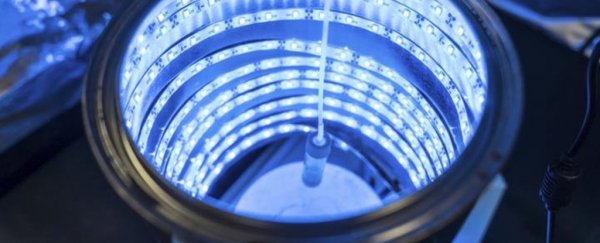Scientists have created an artificial form of photosynthesis that could reduce levels of carbon dioxide in the air, and provide solar fuel at the same time – two potential benefits to help stabilise our changing climate.
The chemical reaction is triggered by blue light mimicking the blue wavelength of sunlight, and converts carbon dioxide into two reduced forms, formate and formamides, which can be used as energy sources.
After the reaction is finished, what's left is cleaner air and excess energy, just like the photosynthesis process in plants that converts light energy to chemical energy. The team from the University of Central Florida has high hopes for its synthetic version.
"Tailoring materials that will absorb a specific colour of light is very difficult from the scientific point of view, but from the societal point of view we are contributing to the development of a technology that can help reduce greenhouse gases," explains one of the researchers, Fernando Uribe-Romo.
As Uribe-Romo points out, scientists have tried to do this sort of thing before, but getting light in the visible spectrum to trigger the right chemical reaction is notoriously tricky.
The materials that can absorb visible light, such as platinum, rhenium, and iridium, tend to be too rare and expensive to be of any practical use for building artificial photosynthesis machines.
Uribe-Romo and his colleagues hit upon the idea of using the more common titanium metal with organic molecules called N-alkyl-2-aminoterephthalates acting as antennae to absorb the incoming blue light.
This metal-organic framework (MOF) did the trick. MOFs have already been used to separate and trap gases over high surface area – in this case, it's CO2 that is soaking into its pores, while the 'antennae' trap the light and provide some electrons, which the titanium oxide uses to convert the CO2.
The researchers set up a cylindrical testing pod fitted with blue lights – which looks a lot like a tiny tanning bed – and let the MOF get to work. The material does the job of trapping the CO2 while the blue light provides the energy to convert it into solar fuel.
For the process to be viable on a larger scale, the scientists say, the efficiency of the system needs to be increased and a bigger spectrum of visible light needs to be captured – but the signs are promising.
With levels of carbon dioxide in our atmosphere exceeding scary thresholds, we need all the help we can get in reducing it, whether from nature our own materials. Scientists are also working on numerous alternative methods for trapping CO2.
As for the new MOF material, it could eventually be set up near power plants to significantly cut down the amount of carbon dioxide released into the atmosphere.
"The gas would be sucked into the station, go through the process and recycle the greenhouse gases while producing energy that would be put back into the power plant," explains Uribe-Romo.
Another possibility is having roof tiles made of this material on homes, material that could clean up some of the air and produce energy at the same time.
"That would take new technology and infrastructure to happen," says Uribe-Romo. "But it may be possible."
You can see Fernando Uribe-Romo explaining the artificial photosynthesis process in the video below:

The findings have been published in Journal of Materials Chemistry A.
